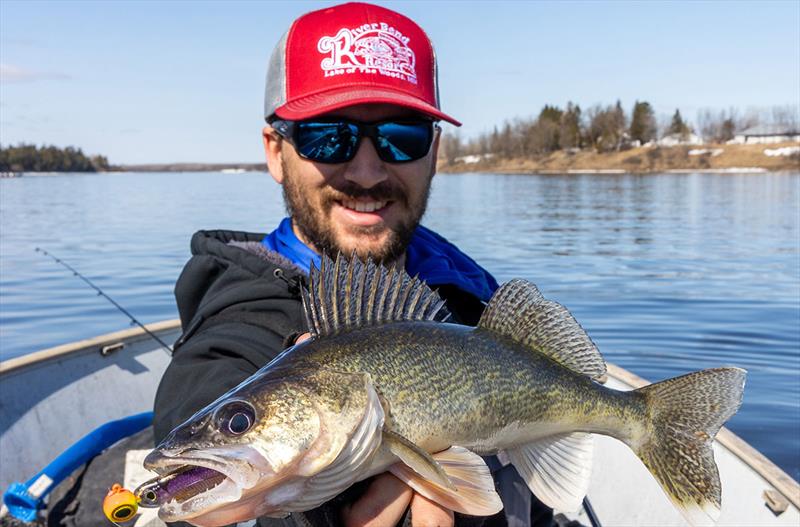
Early season river walleye tactics
by Dan Amundson 21 May 2022 19:01 UTC

River Walleye © Dan Amundson
The transition from winter to spring brings more than a sweet relief from constant snowstorms and freezing temperatures. It's an exciting change for anglers. Ice houses are put away and boats are brought out of hibernation. The sun feels a little warmer, water temps start to rise and walleyes begin their yearly spawning rituals. While spring doesn't guarantee favorable fishing weather, it's worth bundling up and jumping in the boat to target early-season walleyes.
Rivers steal the spotlight when it comes to early-season destinations. Walleyes head upriver to spawn when possible, as the current will help aerate eggs. When fish make their run, anglers sprint to perennial walleye hotspots like the Rainy River, the Fox River, the Detroit River, and the Sandusky River to chase migrating gravel lizards. Those same fish feed aggressively after the spawn completes to rebuild their energy reserves. In fact, the post-spawn walleye bite is, in many ways, much more consistent than the pre-spawn bite.
No matter what body of water anglers choose, finding warm water is key. Warmer water means more active fish. If the water is too cold, walleyes become tight-lipped, spread out and stay in deeper water, leading to frustrating fishing. When water temps reach the low 40's, spawning activity ramps up, meaning big fish start congregating in shallower water. After the spawn is complete, water temps in the 50's mean the walleye feedbags are strapped on tight. If anglers get on the water when these conditions line up, they can experience some of the best fishing of their lives.
Arguably the most popular technique for spring walleyes is a roundhead jig paired with a soft plastic. Available in a variety of shapes, sizes, and colors, soft plastics are effective when pitched, dragged behind the boat or vertically jigged. Water temperatures often dictate what style of plastic to choose.
When water temperatures are still cold or after a spring cold front, a split-tail style plastic like the LIVETARGET Twitch Minnow tends to be most effective. Giving off a subtle presentation, the Twitch Minnow is perfect for lethargic walleyes. Drag it behind the boat in deeper water at 0.3-0.6mph while bouncing the jig off the bottom. If fish are on shallow flats, pitch it out and slowly hop it back while maintaining contact with the bottom.
As the water warms up, use paddletails like the LIVETARGET Slow-Roll Shiner. The oval-shaped tail on these plastics kick out tons of vibration to call in fish. Since the water is warmer, walleyes are more aggressive and willing to investigate a louder bait. Drag paddletails upstream to maximize the action of the tail, or pitch it out and slowly reel it back to the boat, keeping it close to the bottom. Pause the retrieve every so often if a constant retrieve isn't producing.
While these are good guidelines to follow, anglers shouldn't be afraid to use split tails when water is warm or paddletails when water is cold. If fish aren't eating one style, switch to another. The same goes for colors and sizes. Keep changing until something works. Consider subtle, natural colors when the water is clean and visibility is good, and louder, brighter colors when spring rains muddy your favorite river.
Another solid choice for spring walleyes is a lipless crankbait. Giving off tons of vibration and loud rattles, lipless cranks are great lures year-round as they grab the attention of every fish. While it sounds like an aggressive lure best suited for warmer water, lipless cranks produce exceptionally well in cold water too. When walleyes are fussy, throw a lipless crank to trigger a reaction strike. Fish will bite out of irritation even if they're not hungry. The LIVETARGET Golden Shiner Rattlebait is a favorite due to the incredibly loud rattle it has. The livetargetlures.com/collections/yellowperch/products/yellow-perch-rattlebait and the new LIVETARGET Sonic Shad are other outstanding choices. Cast these lures out and let them sink to the bottom. Work them back to the boat popping them off the bottom. Keep the pops small. Raise the baits high enough to feel them vibrate a few times, and let them fall back to the bottom.
Line and leader are important parts of the early season walleye equation. No-stretch braided lines help anglers detect every bait vibration and prevent overworking of the lure. At the same time, the opaque nature of braids can spook wary fish in cold water, so a section of nearly invisible fluorocarbon leader is a must. TUF-Line offers an excellent 8-carrier braid - DOMIN8 - that is specifically formulated and engineered to maximize casting distance, which is perfect for launching lures far from the boat and covering more water on every cast. I use 15 pound-test TUF-Line DOMIN8 on my spinning reels, finished with a six foot leader of 8 pound-test TUF-Line XS Fluorocarbon. Not only does XS Fluorocarbon ensure a stealthy presentation, but its exceptional abrasion resistance provides a measure of insurance against nicks and cuts from rocks, zebra mussels, and of course, sharp walleye teeth.
River conditions are constantly changing and can give anglers some of their most frustrating days of fishing, but the exact opposite can happen too. With thousands of fat springtime walleyes heading to predictable areas, anglers have the chance at not just one, but multiple fish of a lifetime in one day. Grab some soft plastics and rattlebaits, load the boat and take advantage of the best time of year to catch trophy walleye.
Check out Sporting Journal Radio's early-season trip to the Rainy River for some great walleye action: Rainy River Fishing Tips in a Snow Storm